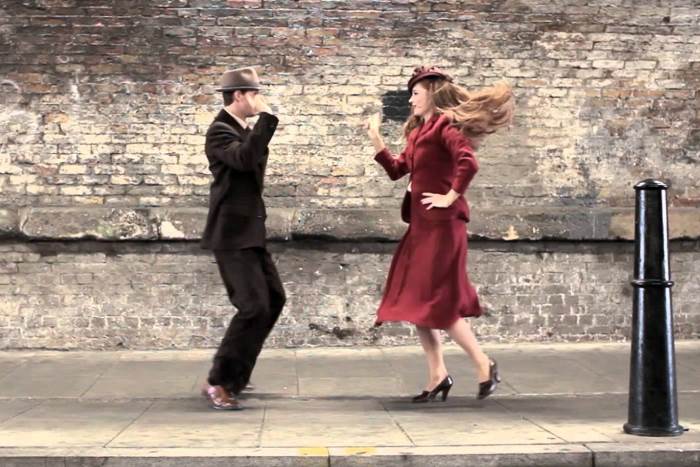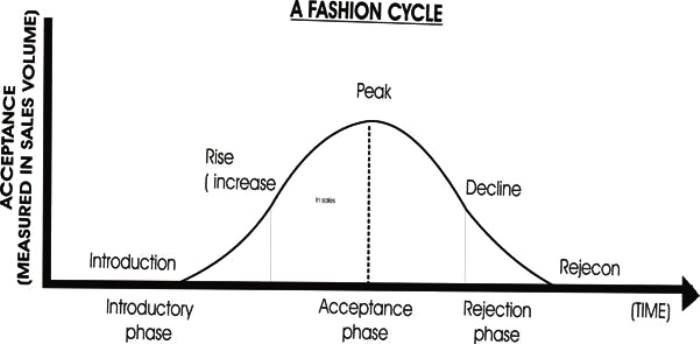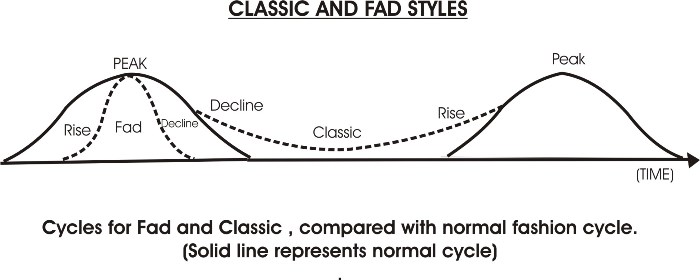Fashion reflects the society and It has been influenced by wars, conquests, laws, religion, and the arts. Individual personalities have also had an impact on fashion. Ever Fashion follows a cycle, and Fashion cycle has no specific measurable time period. Some styles sustain for longer period or some die out soon and some styles come back years after it was declined. So we can say fashion changes with time and has always been evolving to fit the taste, lifestyle and demands of society.
(Photo: YouTube screenshot of 100 years of East London style in 100 seconds – Westfield Stratford City)
FASHION CYCLE
The way fashion change is described as fashion cycle. Before we understand the fashion cycle it is important to know the following terms:
Cycle: Period of time or life span during which fashion exists.
Style: Particular look, shape or type of apparel.
Fashion: Style that is popular during a period of time.
The fashion cycle is usually depicted as a bell- shaped curve encompassing five stages:- Introduction, Rise in popularity, Decline in popularity, and Rejection. Consumers are exposed very season to a multitudes of new styles created by designers or launched by big clothing brands. It is seem some styles are rejected immediately by the buyers on retail level, where as some styles are accepted for a time, as demonstrated by consumers purchasing and wearing them.
With trend reports in new papers and fashion channels showing latest trends many women who consider themselves fashionable, or up to date with what’s new, go out each season to assess what’s needed in order to keep her wardrobe relevant. Then designers also are constantly going back in time for inspiration. Each season a new version of the old era is tapped and we see a few small changes to looks that have all walked down the catwalks before.
STAGES OF A FASHION CYCLE
1. Introduction of a style: Every designer each season works on a new collection, interpret their research into apparel. Every style has some different elements like line, shape, colour, fabric. The first stage of the cycle where the new style is introduced may or may not be accepted by the consumers. Every style is reviewed at design centre and in fashion shows. New styles are usually introduced in high price level. Usually a new style created by a designer is worn by the selected people who can afford it, and mostly these people are Fashion Leaders like celebrities and rich people who loves to experiment and try out new styles to grab the attention of media. Such styles as they are expensive are produced in a small quantity.
2. Increase in popularity: A new style worn by a celebrity or famous personality, seen by many people and it may draw attention of buyers, the press, and the public. Most designers also have prêt line that sells at comparatively low prices and can sell their designs in quantities. Manufacturers adopt design and styles to produce with less expensive fabric or less details. The adaptations are made for mass production.
3. Peak in popularity: Styles at this stage is most popular.When production of any style is in volume, it requires mass acceptance. The manufacturers carefully study trends because the consumer will always prefer clothes that are in the main stream of fashion. When a fashion is at height of its popularity, it may be in such demand that many manufacturers copy it or produce adaptations of it at many price levels. Length at this stage determines if the fashion becomes classic or Fad
4. Decline in popularity: A time comes after the mass production of a few styles people get tired and began looking for new styles. They still wear the particular style but are not willing to buy them at the same price. With the launch of new collection every season the popularity of the style of the previous seasons declines. Fashion is over saturated or flooded the market. Retail stores put such decline styles on sale rake as off season sale or clearing sale.
5. Dejection period:It is the last phase of the cycle. Some consumers have already turned to new looks, thus beginning a new cycle. The rejection or discarding of a style just because it is out of fashion is called consumer obsolescence. Since consumers are no more interested manufactures stop producing the same and the retailers will not restock the same styles. Now it’s time for a new cycle to begin.
LENGTH OF THE CYLES OR FASHION MOVEMENTS
Fashion cycle has no specific measurable time period. Ongoing motion of fashion in the fashion cycle is a movement. Fashion movement is affected by –
1. Economic or social factors
2. Invention of fibres or fabrics
3. Advertising of the product
Rate of the movement varies with each fashion. Short time to peak in popularity, other takes longer some declines slowly, others swiftly.
CLASSICS: Fashion that always remains in the Rise Stage of the Fashion Cycle is known as classic. The styles that remain more or less accepted for an extended period. These styles never become completely obsolete. Example: Classic shirt, Jeans Tailored suit.
FAD : Also know as short- lived fashion and can hold the attention of the consumer for a very short period. The consumer group is very small and the garments are low priced and flood the market in very short time. The consumer gets tired of the designs due to market saturation and they die out soon.
RECURRING CYCLES
Fashion Designers draw inspirations from past. It has been noted that styles reappears years later and is reinterpreted for a new time. A change in element is normal like change in the silhouette or proportion may recur and is sometimes interpreted with a change in fabric and detail. Many nostalgic looks are drawn by designers from the 1940s, 50s, 60s, 70s & 80s. However, the use of different fabrics, colours, and details make the looks unique in every creation.
Check out the videos below for a quick overview of fashion cycles across history.
All fashion history in 140 seconds – 1500 Brasil
100 years of East London style in 100 seconds – Westfield Stratford City




